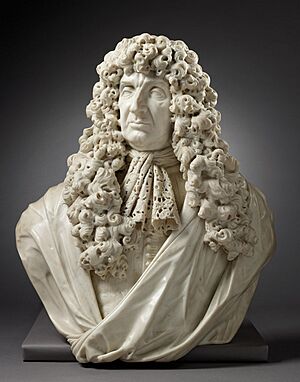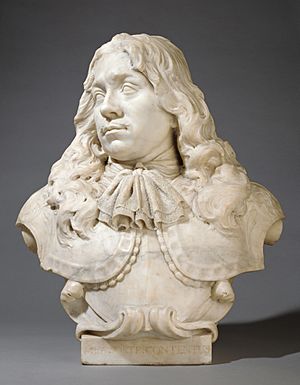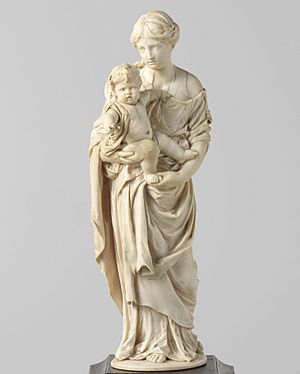Rombout Verhulst facts for kids
Rombout Verhulst (born January 15, 1624 – died November 27, 1698) was a famous Flemish sculptor and artist who drew pictures. He spent most of his working life in the Dutch Republic, which is now the Netherlands.
Rombout Verhulst helped spread the exciting Baroque art style in Dutch sculpture. He worked with another well-known Flemish sculptor, Artus Quellinus the Elder. Together, they decorated the new town hall in Amsterdam. Later, Verhulst became the top sculptor in the Dutch Republic for making marble monuments. These included statues for tombs, garden figures, and beautiful portraits.
Contents
Life of Rombout Verhulst
Rombout Verhulst was born in a city called Mechelen. He learned his skills from sculptors like Rombout Verstappen and Frans van Loo. He might have also studied with Lucas Faydherbe, who was a famous sculptor and architect from Mechelen. People believe he traveled to Italy between 1646 and 1654.
Working in Amsterdam
In 1646, Verhulst moved to Amsterdam. There, he joined the workshop of Artus Quellinus the Elder. Quellinus was a leading Baroque sculptor of his time. From 1650, Quellinus worked for 15 years on the new city hall in Amsterdam. The main architect for this huge project was Jacob van Campen.
Today, this building is known as the Royal Palace on the Dam Square. The marble decorations made by Quellinus and his team became a model for other buildings in Amsterdam. Quellinus invited many Flemish sculptors to help him. Many of these helpers, like Artus Quellinus II and Bartholomeus Eggers, later became famous sculptors themselves.
The sculptures in the Amsterdam city hall made Quellinus's workshop famous around the world. This led to many jobs from other countries, including Germany, Denmark, and England. This helped the Flemish Baroque style spread across Europe. Verhulst was special among Quellinus's helpers because he was the only one who signed his own works on this project. He even had his own assistants, like Nicolaes Millich. At the Amsterdam town hall, he created reliefs of Venus, Fidelity (loyalty), and Silence. He also made clay models for the bronze doors of the Vierschaar (a court area).
Moving to Leiden and The Hague
In 1663, Verhulst worked in Leiden as his own boss. He completed projects for city buildings and made his first funeral monuments. Around 1664, he moved to The Hague. There, he found many private customers, especially the van Reygersbergh family. In 1663, Verhulst finished a funeral monument for Maria van Reygersbergh in a church in Katwijk-Binnen. This was the first private order for this type of work in the second half of the 17th century. Slowly, his main customers changed from Amsterdam to The Hague.
He passed away in The Hague when he was 74 years old.
Rombout Verhulst also taught other artists, including Jan Blommendael and Jan Ebbelaer.
Rombout Verhulst's Artworks
Rombout Verhulst is most famous for his many tomb monuments. But he also created portrait busts (sculptures of heads and shoulders), garden statues, and small artworks made from ivory.
Portrait Sculptures
He made only a few portrait sculptures. This shows that there wasn't a huge demand for them in the Dutch Republic. One of his most well-known portraits is the marble bust of Jacob van Reygersbergh. It was made in 1671 and is now in the Getty Museum in Los Angeles. A clay model for this work is in the Rijksmuseum. It's very similar to the marble version, with only small differences.
This portrait bust shows how skilled Verhulst was and how realistic his style was. He didn't try to make the person look more perfect than they were. Another important portrait bust that people think Verhulst made is of Antonio Lopes Suasso. He was a leading Jewish merchant and banker in Amsterdam. This work was once thought to be by Quellinus, but now experts believe Verhulst made it because of its style. In his clay portraits, he could make people seem alive. He did this by carefully showing their face features and capturing their personality.
Tomb Monuments
Verhulst is mainly remembered for his many tomb monuments. He made these for both private people and public figures. His funeral monument for Maria van Reygersbergh in 1663 made him famous in this area. It had a new and impressive style. He created many church monuments to honor Dutch naval heroes.
His most important work in this area is the decorated tomb of the Dutch naval hero Michiel de Ruyter. It is located in the Nieuwe Kerk (New Church) in Amsterdam. Another important tomb monument was for Carl Hieronymus Baron van In- en Kniphuizen and Anna van Ewsum. It was made for the Dutch Reformed church in Midwolde. Anna, the Baron's widow, asked for it. It was one of the few private orders for tomb monuments in the Dutch Republic.
This tomb is a special version of a traditional "double tomb." This type of tomb shows two figures: one lying down (the dead person) and the other sitting up, resting on an elbow (the living person). In this tomb, the widow Anna van Ewsum is the main focus. She looks directly at the viewer. A statue of the widow's second husband, made by Bartholomeus Eggers, was later added to the tomb. It replaced two small angel figures that held symbols reminding people of death.
Ivory Carvings
Besides his large monuments, Verhulst also made small ivory carvings. His hometown of Mechelen was especially known for this skill. A small ivory sculpture called Virgin and Child in the Rijksmuseum shows how talented he was. He carved the thick, wavy hair of the chubby Christ Child and the heavy cloth with such realism that they almost feel real to touch.
Verhulst's style was influenced by Artus Quellinus. However, he didn't completely copy Quellinus's more classical style. Verhulst's work felt warmer and was made with more detail. In this way, it was more like the sculptors from Antwerp who were close to Peter Paul Rubens, such as Johannes van Mildert and Lucas Faydherbe. Verhulst's work was usually more realistic than Quellinus's and less dramatic.
Selected Artworks by Rombout Verhulst

- Venus and the swan and statues of Modesty and Fidelity (around 1654), in the galleries of the Amsterdam city hall in Amsterdam.
- Decorated tomb of Jan van Galen (around 1655), in the New Church in Amsterdam. The design was by Artus Quellinus, and the sea-battle scene was by Willem de Keyser.
- The tomb of Maarten Harpertszoon Tromp (finished 1656), in the Oude Kerk (Old Church) in Delft. The design was probably by Jacob van Campen, and the sea-battle scene by Willem de Keyser.
- Sculpture on the front of the Waag (1657), Leiden.
- Relief showing the plague as a Fury (1660), above the gate of the plague house in Leiden.
- Epitaph (a writing on a tomb) for Pieter van der Werff (1661), Hooglandse Church, Leiden.
- A lion above the gate at the base of the Burcht at Leiden (1662).
- Tomb of Willem van Lyere and Maria van Reigersberch, Dorpskerk at Katwijk aan den Rijn.
- Tomb for Johan Polyander Kerkhoven (1663), Pieterskerk, Leiden.
- Tomb of Carel Hieronymus van In- and Kniphuisen (1665–69) in the church at Midwolde.
- Epitaph for Hendrick Thibaut and his wife and daughter (1669) in the church of Aagtekerke.
- Epitaph for schout-bij-nacht Willem van der Zaen (1670) in Amsterdam.
- Epitaph for Theodor Graswinckel (1670), Grote Kerk at the Hague.
- Epitaph for Johannes of Gheel (around 1670), church at Spanbroek.
- Tomb for Adriaan Clant (1672), church at Stedum.
- Epitaph for Isaac Sweers (1674), Oude Kerk (Old Church) at Amsterdam.
- Tomb monument of Hieronymus Hieronymus van Tuyll van Serooskerken (around 1675), church at Stavenisse.
- Tomb of lieutenant-admiral Willem Joseph van Ghent (1676), Domkerk in Utrecht.
- Tomb of Michiel de Ruyter (finished 1681), Nieuwe Kerk in Amsterdam.
- Tomb monument for Johan and Cornelis Evertsen (1680–82), Wandelkerk in Middelburg.
See also
 In Spanish: Rombout Verhulst para niños
In Spanish: Rombout Verhulst para niños





